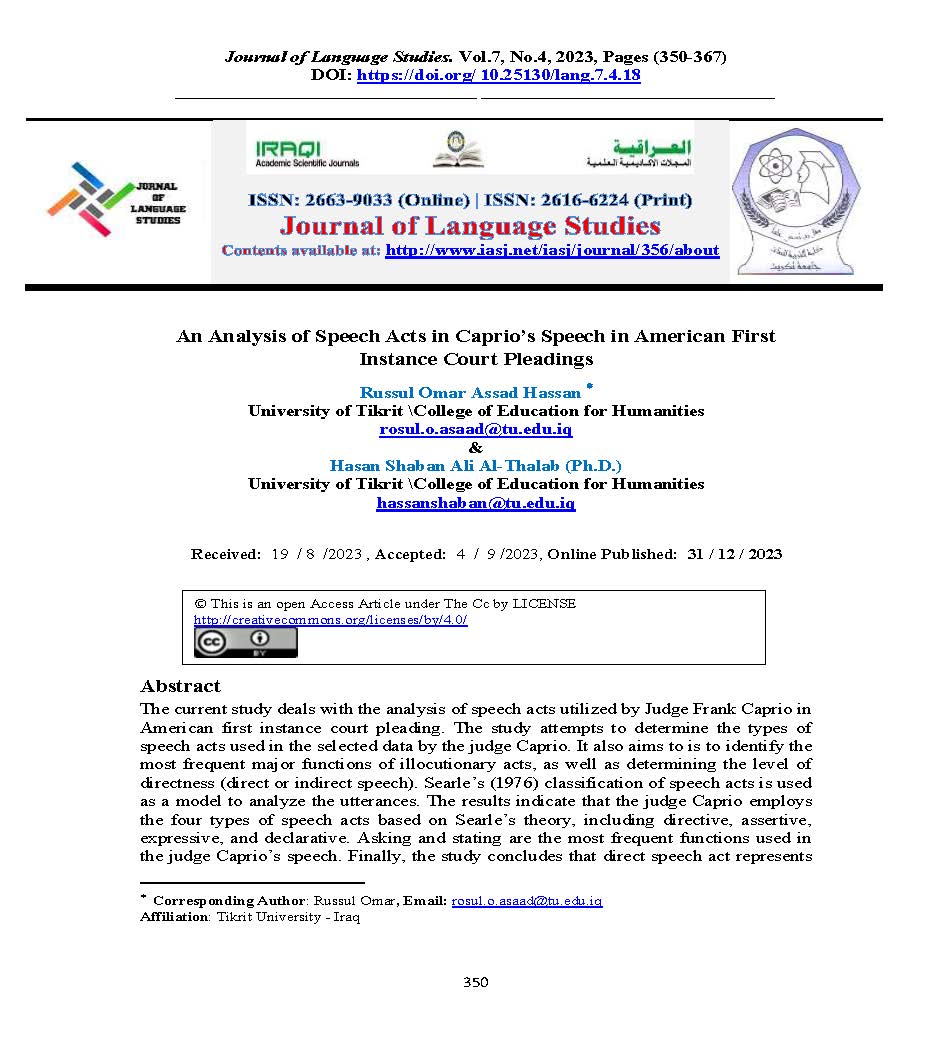An Analysis of Speech Acts in Caprio’s Speech in American First Instance Court Pleadings
DOI:
https://doi.org/10.25130/lang.7.4.18Keywords:
types of speech acts, US initial court, legal language, Judge Caprio, and function of illocutionary actAbstract
The current study deals with the analysis of speech acts utilized by Judge Frank Caprio in American first instance court pleading. The study attempts to determine the types of speech acts used in the selected data by the judge Caprio. It also aims to is to identify the most frequent major functions of illocutionary acts, as well as determining the level of directness (direct or indirect speech). Searle’s (1976) classification of speech acts is used as a model to analyze the utterances. The results indicate that the judge Caprio employs the four types of speech acts based on Searle’s theory, including directive, assertive, expressive, and declarative. Asking and stating are the most frequent functions used in the judge Caprio’s speech. Finally, the study concludes that direct speech act represents the majority of Judge Caprio's speech which indicates the high value of clarity in his utterances.
References
Adolphs, S., Clancy, B., & O'Keeffe, A. (2011). Introducing Pragmatics in Use. Routledge.
Aitchison, J. (1999). Linguistics. British Library Cataloging Publication Data.
Anesa, P. (2011). Courtroom discourses: An analysis of the Westerfield jury trial.
Austin, J. L. (1962). How to Do Things with Words, Clarendon. Oxford, 2005, 619-650.
Bach, K., & Harnish, R. M. (1979). Linguistic communication and speech acts. Cambridge: MIT Press.
Carcaterra, G. (1990). Metodologia giuridica. In: D’Antonio, M. (Ed.), Corso di Studi Superiori Legislativi 1988–1989. Cedam, Padoa, pp. 107-180.
Catoto, J. (2019). Speech acts in Courtroom proceedings. PLC Philippine Linguistics Congress, Metro Manila, Philippine.
Fletcher, G. (2003). “Law”. Barry, S. (ed.), John Searle. Cambridge University Press.
Galdia, M. (2009). Legal linguistics. Peter Lang
Huang, Y. (2007). Pragmatics Oxford University Press.
Levinson, S. C. (1983). Pragmatics. Cambridge university press.
Lyons, J. (1977). Semantics (Vol. 2). Cambridge university press.
Muhammed, H. (2022). Political Accusation in Trump-Biden Presidential Speeches 2020: A Pragmatic Study. University of Tikrit.
Salsabila, M. (2021). AN ANALYSIS OF SPEECH ACT IN SHAKIRA’S SPEECH AT WISE CONFERENCE QATAR (Doctoral dissertation, UIN Raden Intan Lampung).
Searle, J. (1969). An Essay in the Philosophy of Language Cambridge England. Cambridge University Press.
Searle, J. (1976). Speech Acts. London: Cambridge University Press.
Searle, J. (1979). Expression and meaning: Studies in the theory of speech acts. Cambridge University Press.
Stygall, G. (1994). Trial language: differential discourse processing and discursive formation (Vol. 26). John Benjamins Publishing.
Tiersma, P. (2008) What is language and law and does anyone care? In: F. Olsen,
Umar, T. F. (2016). The Analysis of Speech Act of President Joko Widodo at APEC Forum. Universitas Islam Negeri Alauddin Makassar.

Downloads
Published
Versions
- 2023-12-31 (2)
- 2023-12-31 (1)
